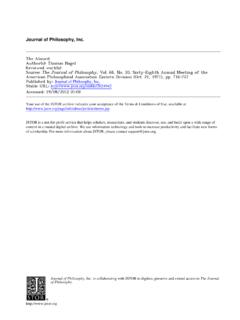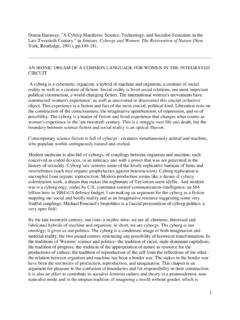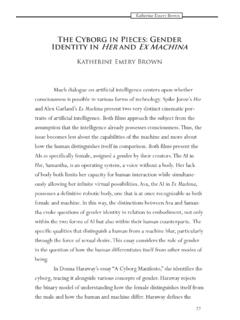Transcription of Sex and the Single Cyborg: Japanese Popular Culture ...
1 SF-TH IncSex and the Single Cyborg: Japanese Popular Culture Experiments in SubjectivityAuthor(s): Sharalyn OrbaughReviewed work(s):Source: Science Fiction Studies, Vol. 29, No. 3, Japanese Science Fiction (Nov., 2002), pp. 436-452 Published by: SF-TH IncStable URL: .Accessed: 19/08/2012 21:49 Your use of the JSTOR archive indicates your acceptance of the Terms & Conditions of Use, available at ..JSTOR is a not-for-profit service that helps scholars, researchers, and students discover, use, and build upon a wide range ofcontent in a trusted digital archive. We use information technology and tools to increase productivity and facilitate new formsof scholarship. For more information about JSTOR, please contact .SF-TH Inc is collaborating with JSTOR to digitize, preserve and extend access to Science Fiction 436 SCIENCE FICTION STUDIES, VOLUME 29 (2002) Sharalyn Orbaugh Sex and the Single Cyborg: Japanese Popular Culture Experiments in Subjectivity I found that these people possessed a method of communicating their experiences and feelings to one another by articulate This was indeed a godlike science, and I ardently desired to become acquainted with it.
2 For I easily perceived that, although I longed to discover myself to the cottagers, I ought not to make the attempt until I had first become master of their language; which knowledge might enable me to make them overlook the deformity of my figure; for with this also the contrast perpetually presented to my eyes had made me acquainted. (Shelley 121-24) What is really being debated in the discourse surrounding a cyborg future are contemporary disputes concerning gender and sexuality, with the future providing a clean slate, or a blank screen, onto which we can project our fascination and fears. (Springer 322) Visual representations of cyborgs are .. not only utopian or dystopian prophesies, but rather reflections of a contemporary state of being. The image of the cyborg body functions as a site of condensation and displacement.
3 It contains on its surface and in its fundamental structure the multiple fears and desires of a Culture in the process of transform-ation. (Gonzalez 267) As Claudia Springer and Jennifer Gonzalez contend, cyborgs are not about the future, they are about contemporary society and its current transformations. In this essay I will discuss recent Japanese narratives that use the figure of the cyborg to explore new paradigms of subjectivity, as the advanced nations of the world become increasingly postmodern, postnational, postindustrial, and even posthuman. In particular, I will focus on two aspects of subjectivity that have been fundamental to the modern-as opposed to postmodern-notion of personhood: sexuality and singularity. The figure of the cyborg-that embodied amalgam of the organic and the technological-confounds the modernist criteria for subjectivity and, when featured in narrative, allows readers/viewers to think through the ramifications of the changes we currently face.
4 The cultural products that engage the notion of the cyborg help us to come to terms with the meaning of this new relationship between the human body and technology as that relationship unfolds: narrative helps us to work through the fears and desires of a particular historical-cultural moment. We are each of us already compelled daily to face the breakdown of the distinction between the mechanical/technological and the organic/biotic. Cyborg narratives allow us, in Jennifer Gonzalez's phrasing, to personify, condense, and displace the anxieties and hopes raised by this situation. Donna Haraway, the best-known theorist of cyborg subjectivity, explains some of the fears and hopes that most fundamentally characterize cyborg narrative: "In retelling origin stories, cyborg authors subvert the central myths of origin of Western Culture .
5 We have all been colonized by those origin myths, with their longing for fulfillment in apocalypse" (175).' She suggests that the only way to avoid the hypocrisies and dangers of Western Culture 's current SEX AND THE Single CYBORG 437 trajectory is to recast origin myths-which cultures use to explain their own ontology and subjectivity to themselves-to confront and subvert narratives of (false) innocence and apocalypse. I would contend that, in general, Japanese Popular - Culture forms work through issues of apocalypse, survival, and the impossibility of establishing innocence far more often and in terms of greater moral complexity than those of North America. For example, Susan Napier has argued that a multitude of Japanese Popular - Culture products-from the 1950s GODZILLA films to the internationally Popular anime film Akira (1988)-can be seen as attempts to grapple with issues arising from the 1945 atomic bombings and the very real possibility of global annihilation that they implied (Anime 197).
6 In the Godzilla films we see another common characteristic of Japanese Popular narrative: both the destructive and the potentially productive aspects of technology are explored. Consequences, including occasionally the pointless deaths of protagonists, are rarely evaded in Japanese Popular narrative. In another sense, too, Japanese cultural production may offer a particularly fertile area for the study of cyborgs and subjectivity. Japanese social discourse incorporates robots and cyborgs with little of the implicit dread often found in North American references. Manga artist SHIRO Masamune has remarked that from childhood Japanese children are educated in robots/robotics. Starting with [the cartoon characters] Astro Boy and Arare-chan, and progressing to Doraemon-these are all robots.
7 Japanese children give robots names and see them as friends, and are raised from the beginning with an image of robots that portrays them as extremely (qtd in Ueno 116). As opposed to the terrifying figure of Darth Vader-one of the first memorable cyborgs encountered by children in North America- Japanese children enjoy a wide range of characters that mix human and machinic Certainly it is difficult to overlook the large number of robots, cyborgs , and "metal fighting suits" in Japanese television, animated videos (anime), and comic books (manga). While many of these narrative products can be dismissed as unimaginative or derivative, others are complex and thoughtful, and their sheer quantity means that the various issues at the heart of the new cyborg paradigm are explored in Japanese Popular Culture perhaps more thoroughly than anywhere else.
8 (And, given the extraordinary popularity of manga and anime outside Japan, this exploration is shared by increasing numbers of international viewers.) Further, Japanese Popular Culture may enjoy a particularly significant, persistent engagement with the cyborgian because of its participation in what I call the "Frankenstein syndrome." I have proposed this notion as a parallel to what film theorist Rey Chow has called the "King Kong syndrome." Drawing inspiration from the 1933 film, she identifies a tendency on the part of Western countries to read the non-West as the "site of the 'raw' material that is 'monstrosity,' [which] is produced for the surplus value of spectacle, entertainment, and spiritual enrichment for the 'First World"' (84). My inflection of the parallel notion, the "Frankenstein syndrome"-inspired by 438 SCIENCE FICTION STUDIES, VOLUME 29 (2002) Mary Shelley's 1818 novel rather than any of the fims-refers to the tendency of developing countries, those defined as "monstrous" and "raw" by the already developed nations, to see themselves in those same terms.
9 When Japan re-opened to the world in the mid-nineteenth century after more than 250 years of isolation, one of the most powerful messages of Western discourse the Japanese absorbed was the "scientifically proven" racial and cultural inferiority of the "Asiatic" race. Less than fifty years later, Japan had replicated every aspect of Anglo-European modernity with astounding success: cutting-edge science, medicine, and technology; a colonial empire supported by a powerful military; a fully developed industrial economy. Nonetheless, after helping the Allied powers defeat Germany in WWI and becoming a founding member of the League of Nations, Japan was once again relegated to the position of anomalous Other by the other founding nations' refusal to incorporate a statement of basic racial equality in its charter (Dower 204).
10 Like the monster in Shelley's Frankenstein, rejected first by his creator and eventually by all the other humans with whom he tried to establish contact, the people of modernizing Japan were forced time and again to recognize that even the complete acquisition of the "godlike science" of language-in the form of the discourses of industrial, post-enlightenment modernism-was not enough to save them from the curse of monstrosity in the eyes of the West. All modern Japanese literature and art has been (and continues to be) produced under the shadow of this recognition, leading to an unusual concern with monstrous or anomalous bodies/subjectivities and various attendant issues. In striking similarity to the key themes in Shelley's Frankenstein, some of the most pressing issues for Japanese modern narrative have been questions of legitimacy and illegitimacy (based on an improperly resolved oedipal crisis), non-normative forms of reproduction, the hybridity of bodies or subjectivities, and ambiguous or anomalous incarnations of gender/ I have written elsewhere about the effects of these culturally-specific concerns on the development of the figure of the cyborg/robot/android in Japanese Popular Culture from 1870 to the Here I will confine myself to discussion of two very recent Japanese cyborg narratives and to a limited set of questions regarding cyborg subjectivity.












